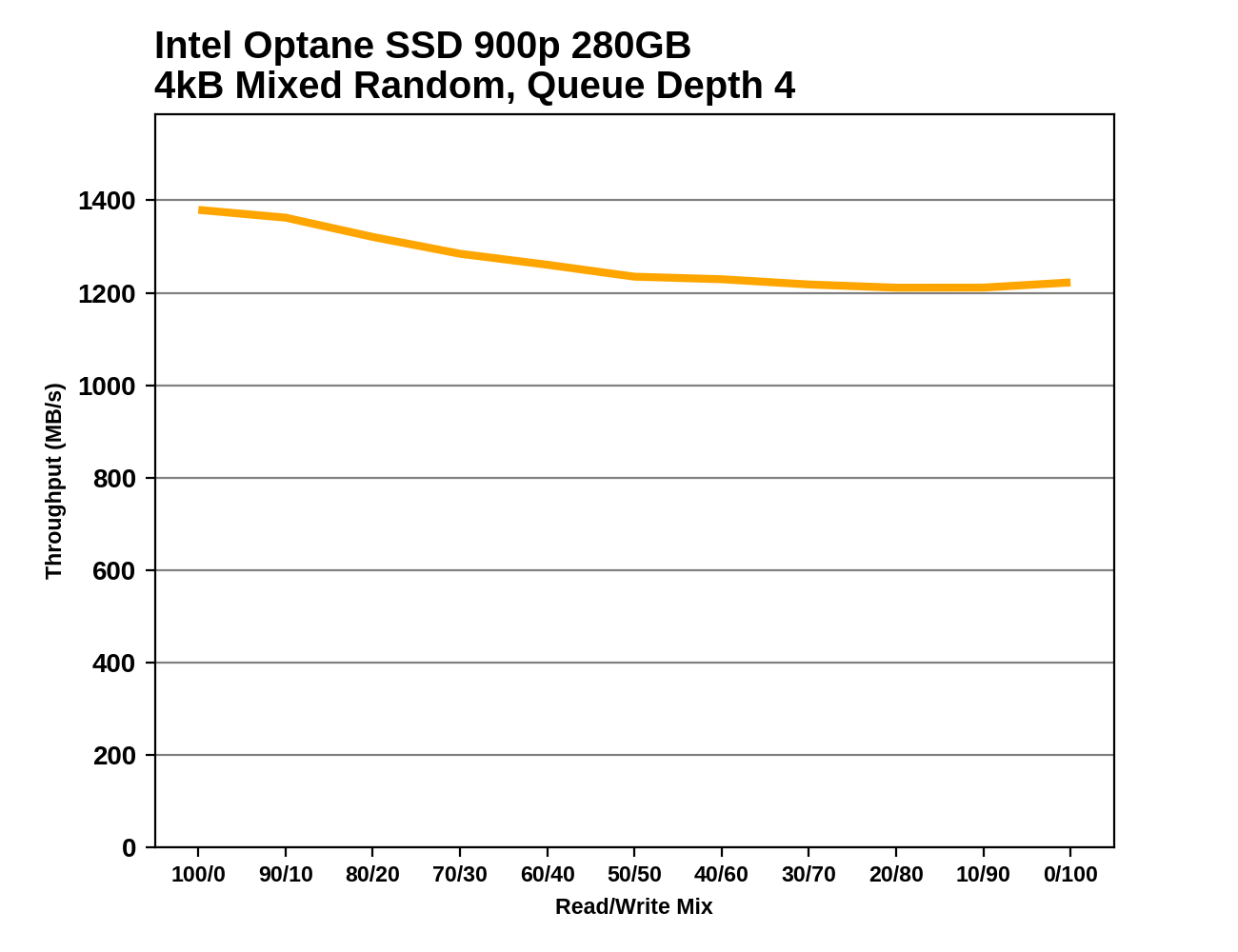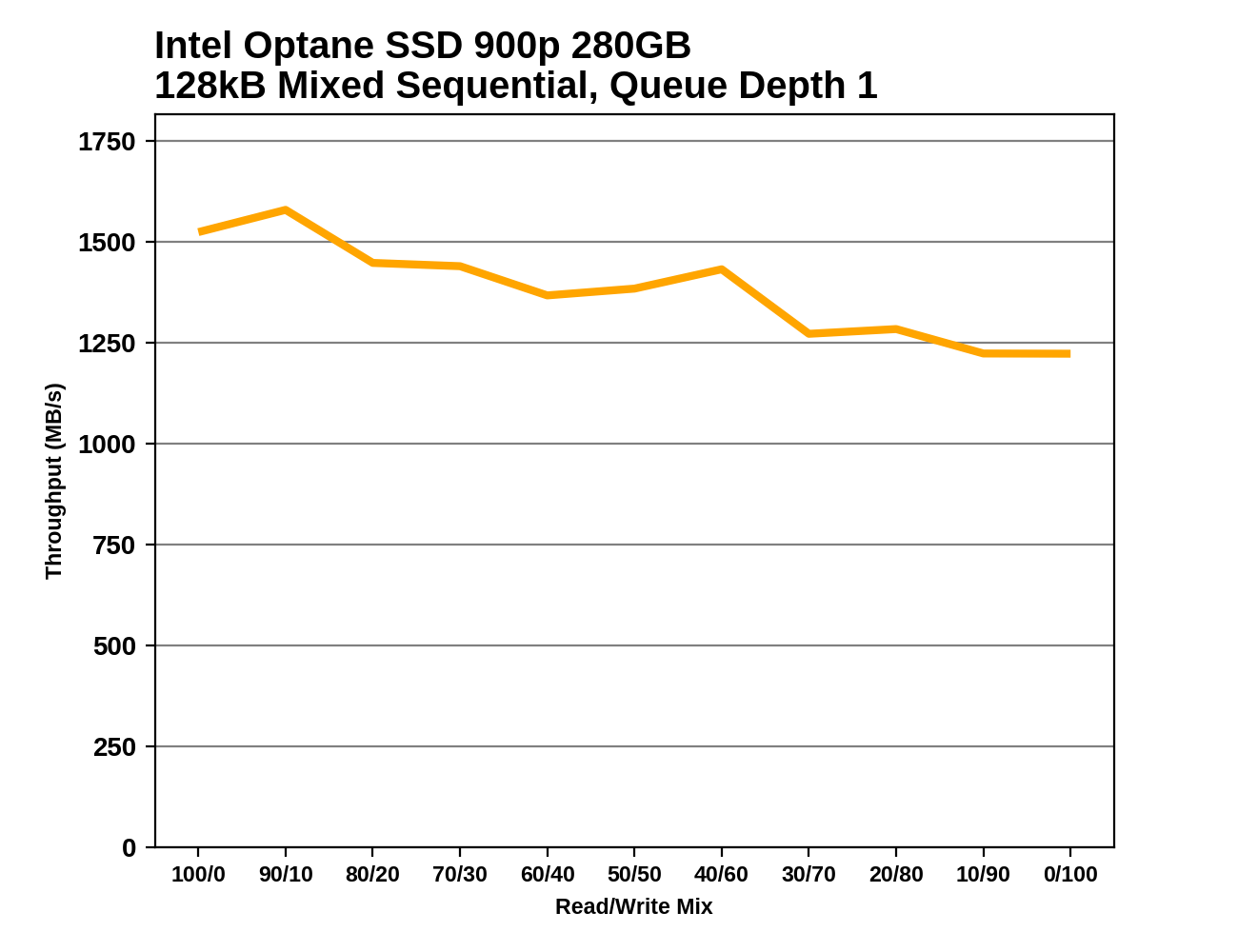The Intel Optane SSD 900P 280GB Review
by Billy Tallis on October 27, 2017 9:30 AM ESTMixed Random Performance
Our test of mixed random reads and writes covers mixes varying from pure reads to pure writes at 10% increments. Each mix is tested for up to 1 minute or 32GB of data transferred. The test is conducted with a queue depth of 4, and is limited to a 64GB span of the drive. In between each mix, the drive is given idle time of up to one minute so that the overall duty cycle is 50%.

The mixed random I/O performance of the Intel Optane SSD 900P is completely unmatched. The small Optane Memory M.2 is the second fastest drive we've tested, and the fastest flash-based SSD is only a third as fast as the Optane SSD overall.
 |
|||||||||
At the very end of the test, when the workload shifts to pure random writes, Samsung's fastest SSDs are able to batch the writes and dramatically improve throughput, almost enough to catch up to the slowest speed the Optane SSD hits during this test.
Mixed Sequential Performance
Our test of mixed sequential reads and writes differs from the mixed random I/O test by performing 128kB sequential accesses rather than 4kB accesses at random locations, and the sequential test is conducted at queue depth 1. The range of mixes tested is the same, and the timing and limits on data transfers are also the same as above.

The Intel Optane SSD 900P doesn't quite dominate the mixed sequential I/O test to the extent that it trounced the competition in the mixed random I/O test, but it still breaks the record with a 40% higher average throughput than the fastest flash-based SSD.
 |
|||||||||
The Optane SSD 900P's performance wavers a bit as the workload changes, but the general trend is a gradual reduction in performance as the proportion of writes increases. The flash-based SSDs tend to show an sharper decline in performance during the first half of the test, and the good ones recover most of that performance over the course of the second half. But the low performance in the middle of the test brings the averages way down and leaves the Optane SSD alone at the top.










205 Comments
View All Comments
ddriver - Friday, October 27, 2017 - link
You probably missed the slide where intel positions this product at "eSports" - believe it or not, it will make a world of a difference. You may not see even 1% of improvement, but it will definitely make you much better at eSports.But then again, you can get exactly the same benefit from just putting a sticker on your box, without actually paying for the product. It is enough for others to think you have it.
Sarcasm aside, at this price it is a good purchase for database usage. But only if very low latency is required, meaning a local server on a very fast network, and the server is being lightly loaded. For an internet server the advantages will be diminished by the internet connection bottleneck, and for higher loads, as evident from the test results, SSDs do catch up as the QD increases, and still offer significantly lower cost per GB.
lmcd - Friday, October 27, 2017 - link
While the endurance shut-off seems pretty ridiculous, I'd imagine as this technology ramps up its density and cost-efficiency it will supplant traditional NAND in the data center before traditional NAND even garners much of a foothold.iwod - Saturday, October 28, 2017 - link
I think the reality is 90% of consumers are never going to hit that endurance number, ever. Statiscally speaking, they are much more likely to get a Memory Error, Capacitor malfunction, Power Supply issues or likely their CPU heat cooling system ( Increasingly a problem ) messed up before that number ever arrived.And I think another problem, is Intel cant figure out the best endurance time and method on this new tech. And they are playing it safe then sorry. Running a 10 PB test takes time.
"Bullwinkle J Moose" - Friday, October 27, 2017 - link
Thank you ddriverI was going to let the My Banhammer stand until I remembered why I love this site so much...
It's not the articles, it's the comments
You have learned well my friend!
eddman - Sunday, October 29, 2017 - link
Horses attached to the same carriage. Keep pulling.peevee - Friday, October 27, 2017 - link
Looks like this thing is fast enough to be used as swap drive for memory-intensive tasks.Reflex - Friday, October 27, 2017 - link
This is a good product for those who can benefit from it, and a great start for the first major advance in solid state storage we have seen in many years. Hopefully the price continues to come down, power consumption declines and capacity rises. I will be very interested in seeing whether or not they can achieve the projections that were made when the technology was first announced.Huayra - Friday, October 27, 2017 - link
Is it possible to install macOS on it using thunderbolt enclosure connected to a Macbook?Ippokratis - Saturday, October 28, 2017 - link
Hi, nice article.1 - Can Optane be used as a scratch disk for Ryzen / Threadripper, OSX /Linux ?
2 - Could you please a compiler (gcc, javascript) benchmark ? Random IOPS are very important in compiling and making compile times shorter is a good reason to buy tech - consider it as a real life test.
Thanks
peevee - Monday, October 30, 2017 - link
Agree with compile test. On 16+ core machine though, not 4 measly cores. And source code which does not all fit in RAM.